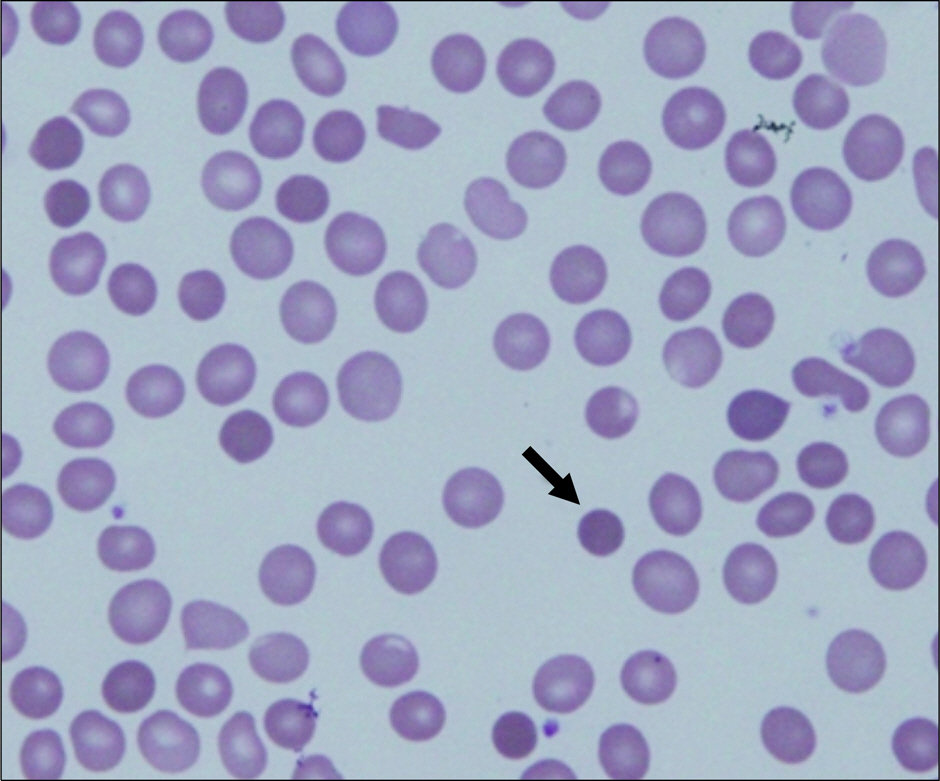Korean J Gastroenterol.
2013 Mar;61(3):166-169. 10.4166/kjg.2013.61.3.166.
A Case of Hereditary Spherocytosis Coexisting with Gilbert's Syndrome
- Affiliations
-
- 1Department of Internal Medicine, Korea Cancer Center Hospital, Korea Institute of Radiological and Medical Sciences, Seoul, Korea. mdhyejin@gmail.com
- 2Department of Laboratory Medicine, Korea Cancer Center Hospital, Korea Institute of Radiological and Medical Sciences, Seoul, Korea.
- KMID: 1501640
- DOI: http://doi.org/10.4166/kjg.2013.61.3.166
Abstract
- We recently encountered a case of hereditary spherocytosis coexisting with Gilbert's syndrome. Patient was initially diagnosed with Gilbert's syndrome and observed, but other findings suggestive of concurrent hemolysis, such as splenomegaly and gallstones were noted during the follow-up period. Therefore, further evaluations, including a peripheral blood smear, osmotic fragility test, autohemolysis test, and red blood cell membrane protein test were performed, and coexisting hereditary spherocytosis was diagnosed. Genotyping of the conjugation enzyme uridine diphosphate-glucuronosyltransferase was used to confirm Gilbert's syndrome. Because of the high prevalence rates and similar symptoms of these 2 diseases, hereditary spherocytosis can be masked in patients with Gilbert's syndrome. In review of a case and other article, the possibility of the coexistence of these 2 diseases should be considered, especially in patients with unconjugated hyperbilirubinemia who also have splenomegaly and gallstones.
MeSH Terms
-
Adult
Erythrocytes/physiology
Gallstones/etiology
Genotype
Gilbert Disease/complications/*diagnosis/genetics
Glucuronosyltransferase/genetics
Hemolysis
Humans
Hyperbilirubinemia/etiology
Male
Polymorphism, Single Nucleotide
Spherocytosis, Hereditary/complications/*diagnosis/genetics
Splenomegaly/etiology
Glucuronosyltransferase
Figure
Cited by 1 articles
-
Coexistence of Gilbert Syndrome and Hereditary Spherocytosis in a Child Presenting with Extreme Jaundice
Jae Hee Lee, Kyung Rye Moon
Pediatr Gastroenterol Hepatol Nutr. 2014;17(4):266-269. doi: 10.5223/pghn.2014.17.4.266.
Reference
-
References
1. Perrotta S, Gallagher PG, Mohandas N. Hereditary spherocytosis. Lancet. 2008; 372:1411–1426.
Article2. Bolton-Maggs PH, Langer JC, Iolascon A, Tittensor P, King MJ. General Haematology Task Force of the British Committee for Standards in Haematology. Guidelines for the diagnosis and management of hereditary spherocytosis-2011 update. Br J Haematol. 2012; 156:37–49.3. Kim YH, Yeon JE, Jung GM, et al. A study of polymorphism in UDP-glucuronosyltransferase 1 (UGT-1A1) promoter gene in Korean patients with Gilbert's syndrome. Taehan Kan Hakhoe Chi. 2002; 8:132–138.4. Garg PK, Kumar A, Teckchandani N, Hadke NS. Hereditary spherocytosis coexisting with Gilbert's syndrome: a diagnostic dilemma. Singapore Med J. 2008; 49:e308–e309.5. Sugita K, Maruo Y, Kurosawa H, et al. Severe hyperbilirubinemia in a 10-year-old girl with a combined disorder of hereditary spherocytosis and Gilbert syndrome. Pediatr Int. 2007; 49:540–542.
Article6. Sharma S, Vukelja SJ, Kadakia S. Gilbert's syndrome coexisting with and masking hereditary spherocytosis. Ann Hematol. 1997; 74:287–289.
Article7. Lee HJ, Moon HS, Lee ES, et al. A case of concomitant Gilbert's syndrome and hereditary spherocytosis. Korean J Hepatol. 2010; 16:321–324.
Article8. Berk K, Korenblat K. Approach to the patient with jaundice or abnormal liver test. Cecil RL, editor. Goldman's cecil medicine. 24th ed.Philadelphia: Elsevier;2012. p. 956–966.9. Maruo Y, D'Addario C, Mori A, et al. Two linked polymorphic mutations (A(TA)7TAA and T-3279G) of UGT1A1 as the principal cause of Gilbert syndrome. Hum Genet. 2004; 115:525–526.10. Elghetany M, Banki K. Erythrocytic disorders. Henry JB, McPherson RA, Pincus MR, editors. Henry's clinical diagnosis and management by laboratory methods. 22nd ed.Philadelphia: Elsevier;2011. p. 557–600.
Article11. del Giudice EM, Perrotta S, Nobili B, Specchia C, d'Urzo G, Iolascon A. Coinheritance of Gilbert syndrome increases the risk for developing gallstones in patients with hereditary spherocytosis. Blood. 1999; 94:2259–2262.
Article12. Lee YK, Cho HI, Park SS, et al. Abnormalities of erythrocyte membrane proteins in Korean patients with hereditary spherocytosis. J Korean Med Sci. 2000; 15:284–288.
Article
- Full Text Links
- Actions
-
Cited
- CITED
-
- Close
- Share
- Similar articles
-
- Coexistence of Gilbert Syndrome and Hereditary Spherocytosis in a Child Presenting with Extreme Jaundice
- A case of concomitant Gilbert's syndrome and hereditary spherocytosis
- Hereditary Spherocytosis Coexisting with UDP-Glucuronosyltransferase Deficiency Highly Suggestive of Crigler-Najjar Syndrome Type II
- Serial CT Findings of Resolving Extramedullary Hematopoiesis as Unilateral Posterior Mediastinal Mass after Splenectomy in Hereditary Spherocytosis: A Case Report
- A Case of Adrenal Myelolipoma Associated with Hereditary Spherocytosis



